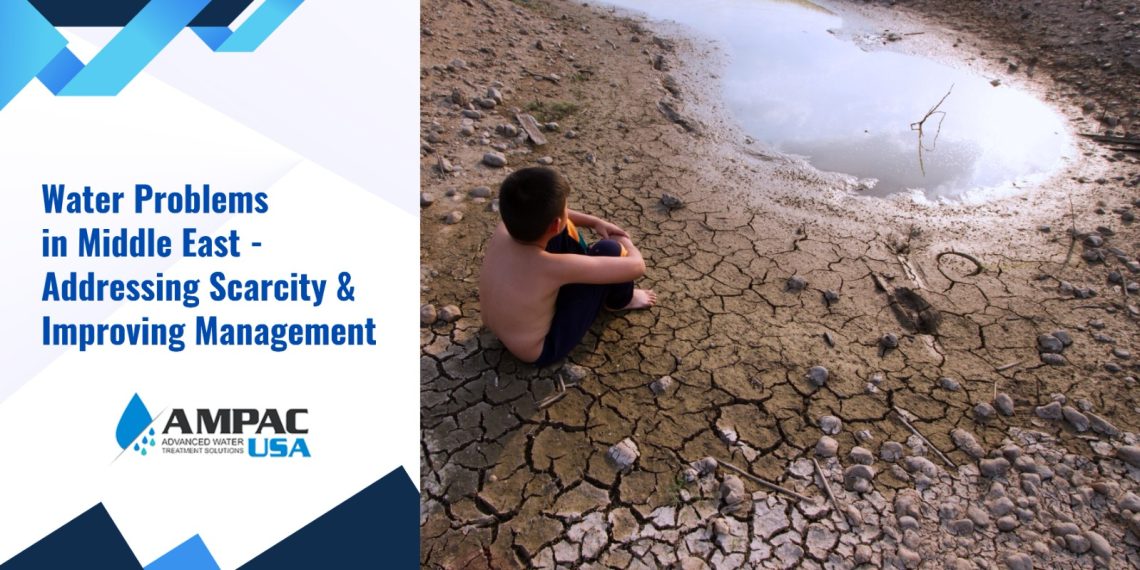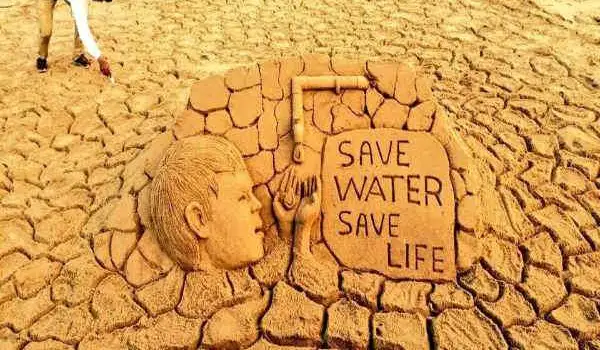Last updated on March 31st, 2025 at 12:14 pm
Middle East water problems stem from its arid climate, limited freshwater supplies, and the troubling effect of climate change. The absence of adequate water resources often falls short of serving the rising population. Bahrain, Kuwait, Qatar, Lebanon, Oman, Cyprus, and the United Arab Emirates are the most water-stressed countries in the world. This chronic and severe water scarcity brings associated problems like food insecurity, limited industrial capacity, and health issues. However, with sustainable water management techniques, Middle East water problems can be reduced to a great extent.
Root Causes of Middle East’s Water Problems
Geographical and climatic conditions, rising population, mismanagement of water resources, and political and economic factors are major causes of the water crisis in the Middle East. Until some time ago, Iraq was the only Middle Eastern country with sufficient water resources at present. However, unlike Lebanon, the nation is significantly disadvantaged for procuring over 65% of its water resources as the river flows from Turkey.
Arid and semi-arid climate
The arid climate in Middle East countries is the primary cause of its constant state of water scarcity. In fact, climate-related water scarcity is set to lower GDP in the Arab states by nearly 14% by 2050! The mostly flat and desert landscape of Middle East and North African countries is not ideal for large surface water systems borne from high-elevation headwaters. The low rainfall and high evaporation rates significantly limit the availability of freshwater sources and keep the region’s water supply scarce. The situation is being exacerbated by the looming climate change.
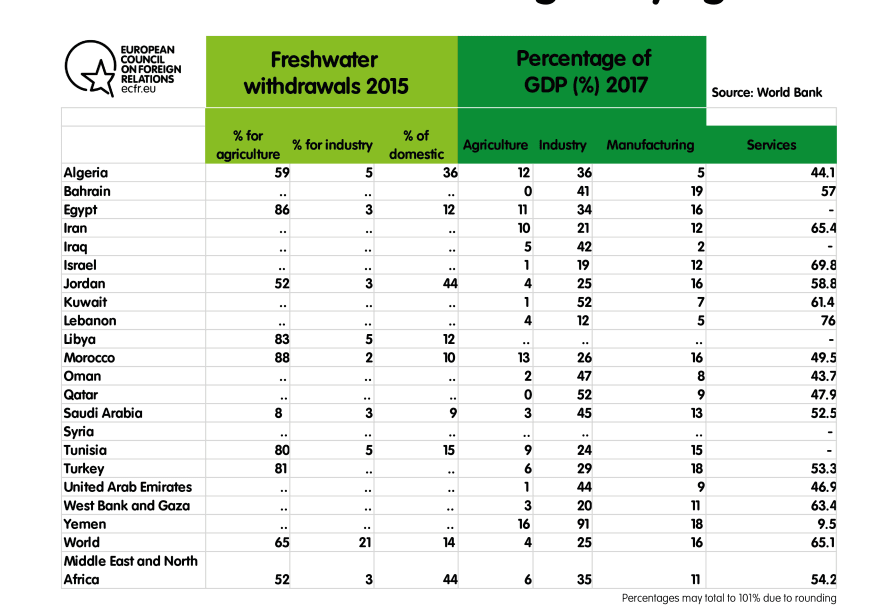
Source: ecfr.eu
Population growth
By 2029, the population of Middle East countries will be 604.38 million. The continuously growing population is another cause for scarce water supplies as it increases the demand for water in all sectors, including agricultural, industrial, and domestic.
By 2050, half of Middle East and North African (MENA) countries will swell in population by over 50 percent compared to 2015. This is more true for Iraq, Palestine, and Sudan. Moreover, those living in rural areas and refugee camps in the GCC countries are more likely to experience the brunt of water scarcity as they lack the financial means to acquire water.
Population Growth and Fresh Water in Middle East and North Africa
| Population (millions) | |||||
| 1970 | 2001 | 2025 | % of Population Living in Urban Areas, 2001 | Annual Renew- able Fresh Water (km2)b | |
| MENAa | 173.4 | 385.6 | 568 | 59 | 632.3 |
| Algeria | 13.8 | 31 | 43.2 | 49 | 14.3 |
| Bahrain | 0.2 | 0.7 | 1 | 88 | 0.1 |
| Egypt | 35.3 | 69.8 | 96.2 | 43 | 86.8 |
| Iran | 28.8 | 66.1 | 88.4 | 64 | 137.5 |
| Iraq | 9.4 | 23.6 | 40.3 | 68 | 96.4 |
| Israel | 3 | 6.4 | 8.9 | 91 | 2.2 |
| Jordan | 1.6 | 5.2 | 8.7 | 79 | 0.9 |
| Kuwait | 0.7 | 2.3 | 4.2 | 100 | 0.02 |
| Lebanon | 2.5 | 4.3 | 5.4 | 88 | 4.8 |
| Libya | 2 | 5.2 | 8.3 | 86 | 0.6 |
| Morocco | 15.3 | 29.2 | 40.5 | 55 | 30 |
| Oman | 0.7 | 2.4 | 4.9 | 71 | 1.0 |
| Qatar | 0.1 | 0.6 | 0.8 | 91 | 0.1 |
| Saudi Arabia | 5.7 | 21.1 | 40.9 | 83 | 2.4 |
| Syria | 6.3 | 17.1 | 27.1 | 50 | 46.1 |
| Tunisia | 5.1 | 9.7 | 12.5 | 62 | 4.1 |
| Turkey | 35.3 | 66.3 | 85.2 | 66 | 200.7 |
| United Arab Emirates | 0.2 | 3.3 | 4.5 | 84 | 0.2 |
| Yemen | 6.3 | 18 | 39.6 | 26 | 4.1 |
Source: prb.org
Mismanagement of water resource
Water over-extraction and mismanagement are major contributors to the Middle East’s water crisis, leading to severe depletion of groundwater, increased water stress, and long-term unsustainability. This is due to the unequal distribution of water resources. According to a report by the World Bank, 82 percent of the water in the MENA region is used inefficiently despite its shortage. The total water productivity here is only about half of the global average because of intermittent floods and droughts.
Inefficient methods of agricultural water use like flood irrigation and growing water-intensive crops, and overexploitation of groundwater resources are major ways in which water is mismanaged. There is no culture for rationalizing water consumption, which is why countries like Egypt have launched many national awareness campaigns.
Water disputes and conflicts
Transboundary water disputes in the Nile and Tigris-Euphrates River Basins, have dismantled relations among the riparian nations. Additionally, the provisions in the Oslo Accords gave Israel the right to use 80% of the groundwater aquifer’s resources and leave only 20% for the Palestinians.
However, today, despite the population of Palestine growing exponentially, Israel is still using around 86% of the aquifers resources and leaving just 14% for the Palestinians.
Not only this but bombing and military action by Israelis have demolished over 50 water and sanitation structures in the West Bank since January 2016. The result is a substantial lack of water in Palestine.
Effects of Water Scarcity in the Middle East
The effects of water shortage in the Middle East and North African countries are observable in declining crop yields, lack of clean drinking water, and regional conflicts.
The worsening water stress due to decades of poor governance, absence of security, and population growth will be making water a contested resource and increasing the risk of social unrest and violence.
Water scarcity and desertification make the availability of reliable water resources and suitable land for growing crops deficient for farmers. As a result, the government relies on importing food from other water-rich countries outside the region.
Additionally, a potential health crisis due to the absence of adequate pure water is a major concern. Recently, in Syria, people extracted contaminated water from the Euphrates River because of continued shortages and used it without proper treatment. This led to many outbreaks of waterborne illnesses like cholera in the local population.
Water resources are unequally distributed in the Middle East. This, coupled with population growth, has given rise to water-related conflicts and marred the peace of countries in the Middle East. In Syria, water shortages have driven rural populations to migrate to urban areas, increasing social tensions and dissatisfaction with the government. This migration is a part of the broader refugee crisis that further strains resources in already water-scarce regions like Iraq and Yemen.
Sustainable Solutions to Address the Middle East Water Problems
It is imperative to think about water management solutions in the Middle East through a regional perspective and through international mediation and support. Several technologies and approaches have been adopted and should gain more momentum to mitigate this crisis. These include seawater desalination using reverse osmosis, recycling water for reuse, smart irrigation systems, and cloud seeding. In addition, transboundary water management will help in regional cooperation.
1. Desalination – Converting Seawater into Freshwater
Desalination involves removing salt and impurities from seawater to make it potable. This is achieved using methods such as:
- Reverse Osmosis (RO): Uses a semipermeable membrane to remove salt and contaminants.
- Multi-Stage Flash Distillation (MSF): Boils seawater at different pressure stages, collecting pure vapor and condensing it.
- Electrodialysis (ED): Uses electrical currents to remove salt.
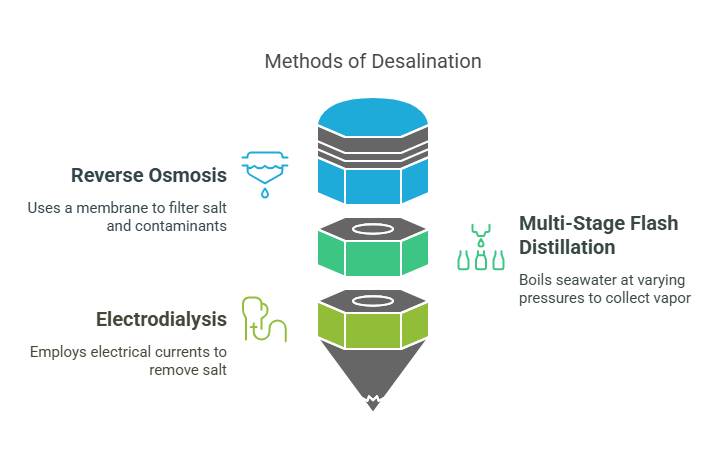
Examples: Saudi Arabia and UAE have some of the largest Seawater desalination plants in the world. Israel produces 75% of its drinking water from desalination.
2. Wastewater Treatment & Reuse for Recycling Water
In wastewater treatment process, used water from households, industries, and agriculture is treated and reused for:
- Irrigation in agriculture
- Industrial cooling and processes
- Groundwater recharge
Types of wastewater treatment:
- Membrane Bioreactors (MBR): Uses biological processes and filtration for high-purity treatment.
- Activated Sludge Process (ASP): Uses bacteria to break down organic matter.
- Tertiary Treatment: Further purifies wastewater for potable reuse.
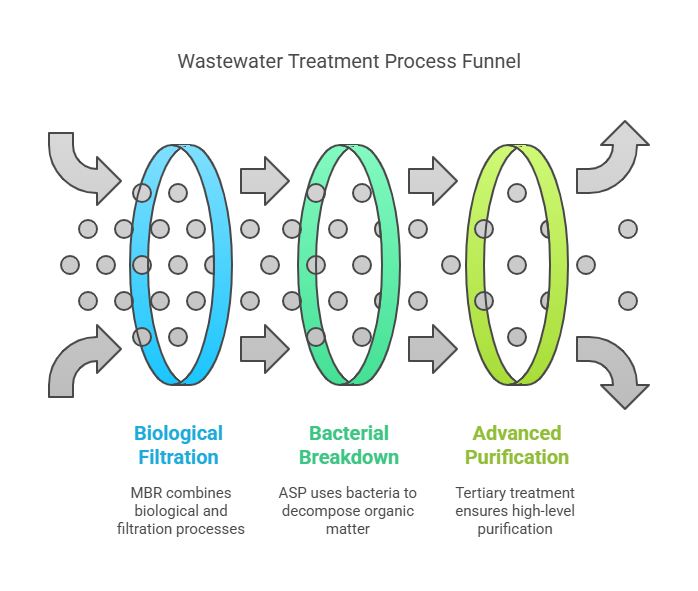
Examples: Israel recycles almost 90% of its wastewater for irrigation. Jordan & UAE are expanding reuse programs in agriculture.
3. Water Conservation & Efficiency to Reduce Wastage
Smart irrigation systems play a crucial role in water conservation across the Middle East. Drip irrigation significantly reduces water usage by delivering water directly to plant roots, saving up to 50% more water than traditional methods. Additionally, AI-based irrigation scheduling optimizes water distribution, ensuring that crops receive the right amount at the right time.
Examples: Saudi Arabia’s Vision 2030 aims to reduce water consumption per capita by 43%. UAE’s Sustainable Water Strategy 2036 focuses on optimizing water use in urban areas.
4. Solar-Powered Desalination for Sustainable Freshwater Production
Instead of fossil fuels, desalination plants can use:
- Solar Thermal Energy: Heats seawater directly for evaporation and condensation.
- Photovoltaic (PV) Power: Provides electricity for Reverse Osmosis desalination.
- Hybrid Solar-Wind Systems: Used in remote desert areas.
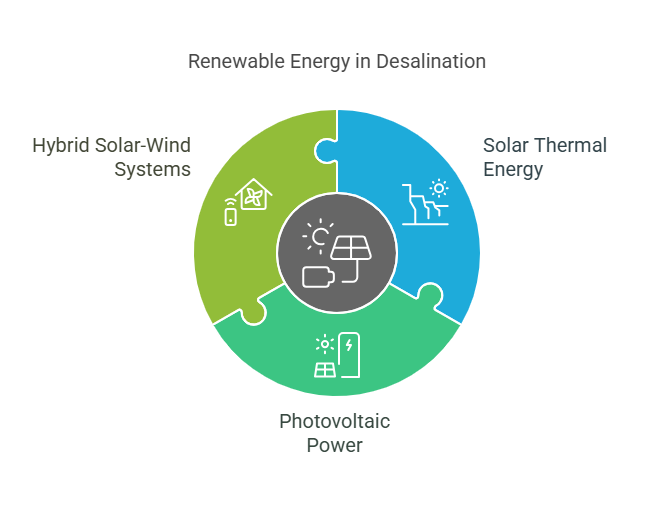
It reduces carbon footprint and is a sustainable solution for energy-scarce regions. The approach is scalable for off-grid rural communities.
Examples: Neom and Saudi Arabia plan to power 100% of their desalination plants with solar energy. Masdar in UAE is running pilot solar desalination projects to scale up efficiency.
5. Cloud Seeding for Enhancing Rainfall
In this process, planes inject silver iodide or salt particles into clouds to encourage condensation and rainfall. This approach increases rainfall in arid regions and is cost-effective compared to building large-scale desalination plants.
Examples: UAE invested $15 million in cloud seeding research. Saudi Arabia & Iran regularly conduct cloud seeding operations.
6. Transboundary Water Management Through Regional Cooperation
Middle Eastern countries that share water sources should collaborate to manage water efficiently. This is achievable through water-sharing agreements, joint seawater desalination projects, and investment in shared reservoirs & infrastructure.
Examples: The Israel-Jordan Water Agreement provides desalinated water to Jordan in exchange for freshwater access from the Jordan River. The Euphrates-Tigris River Cooperation involves Turkey, Syria, and Iraq coordinating water flow from major rivers.
7. Incentivizing Water Conservation
Incentivizing water conservation by imposing water tariffs can reduce water problems in the Middle East. Higher prices typically encourage consumers to reduce waste, repair leaks, and adopt more efficient water-use practices. Other ways that are being explored by MENA countries include charging for extracting water, pricing water, giving conservation subsidies, and charging more during specific seasons or times of the year.
Solving the Middle East Water Crisis
Water scarcity is a critical issue in the Middle East with severe implications for multiple sectors and humankind. It demands a comprehensive and cooperative approach. Investment in water management and treatment technologies will be crucial in the coming period. Ampac USA is a leading manufacturer of energy-powered desalination plants and reverse osmosis water purification systems. We use cutting-edge technology in our systems to make drinking and potable water for various industries, municipalities, and emergency response applications. Our solutions are designed to tackle the region’s growing water crisis by offering high-efficiency desalination, wastewater recycling, and smart purification systems that optimize water use and reduce wastage.

